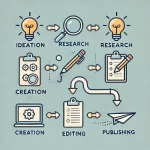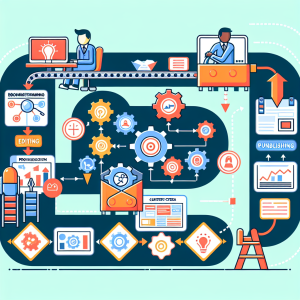
Introduction
In today’s fast-paced digital landscape, the efficiency of content creation and distribution has become more critical than ever. The concepts of content pipelines and content workflows play a pivotal role in ensuring that content is produced and delivered seamlessly. Mastering these processes can significantly enhance productivity and the quality of content output, making them essential for any content-centric organization. This topic is especially relevant now as digital transformations and remote working trends deepen across industries. Understanding these frameworks can help content creators, marketers, and businesses stay competitive and responsive to audience needs.
Main Points
Optimizing Content Pipelines
Content pipelines refer to the systematic series of steps and tools used to produce and deliver content from inception to publication. They are akin to an assembly line in a factory, designed to streamline the creation process and ensure a smooth and efficient workflow. To optimize your content pipeline:
- Analyze Current Processes: Conduct a thorough audit of your existing content creation steps. Identify bottlenecks, repetitive tasks, and areas where improvements can be made.
- Implement Automation: Use automation tools to handle repetitive tasks such as scheduling posts, social media sharing, and basic editing.
- Standardize Procedures: Create standardized templates and guidelines to maintain consistency in content quality and style.
- Continuous Monitoring: Regularly review and adjust the pipeline to adapt to new tools, techniques, and changes in audience preferences.
For example, in a video production company, the content pipeline may consist of scriptwriting, filming, editing, and publishing the video to various platforms. Optimizing each of these stages with specific tools and processes ensures consistency and high quality at every step.
Optimizing Content Workflows
Content workflows are the operational frameworks that facilitate the movement of content through the pipeline stages. They define who is responsible for what task, the sequence of tasks, and the criteria for completion. To optimize your content workflows:
- Define Clear Roles and Responsibilities: Ensure everyone involved in content creation knows their specific roles and tasks. This reduces confusion and ensures accountability.
- Streamline Task Sequences: Organize tasks in a logical order to minimize delays and overlaps. Use project management tools to keep track of progress and deadlines.
- Incorporate Flexibility: While having a structured workflow is important, allow room for creative exploration and iterative improvements.
- Feedback Loops: Establish regular feedback loops to identify issues early and make necessary adjustments promptly.
For instance, in a blogging team, a typical workflow might involve brainstorming topics, outlining, drafting, editing, and final approval. By clearly delineating responsibilities and establishing deadlines, workflows help ensure that every piece of content is ready for publication in a timely manner.
Counterarguments
Some may argue that rigid content pipelines and workflows can stifle creativity and flexibility. While this concern is valid, it’s important to recognize that well-designed processes can incorporate periods for creative exploration and iterative improvements. The key lies in balancing structure with flexibility.
Another counterargument is the initial time and resource investment required to set up these systems. While the setup phase can be resource-intensive, the long-term benefits of having streamlined processes far outweigh the initial costs. By reducing inefficiencies and inconsistencies, businesses can achieve higher quality and more consistent content output.
Conclusion
In summary, content pipelines and workflows are vital mechanisms for producing high-quality content efficiently. They provide a structured approach to content creation, which in turn enhances productivity and ensures consistency. Given the increasing pressure to generate and publish content quickly, understanding and implementing these systems is more important than ever.
For those looking to optimize their content operations, start with a thorough audit of your current processes. Identify bottlenecks and areas for improvement, and gradually introduce changes to your pipeline and workflows. Engaging your team in this process can also provide valuable insights and foster a more collaborative environment.
I encourage readers to reflect on their content creation processes and consider the potential benefits of integrating sophisticated pipelines and workflows. Feel free to find out more or engage in a deeper discussion on how these concepts can be tailored to different industries and content types.





No comment yet, add your voice below!